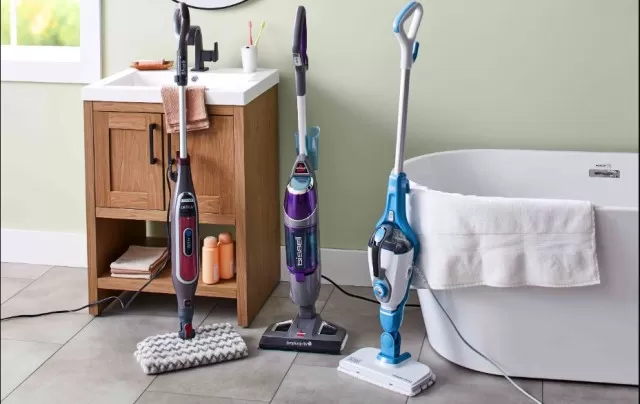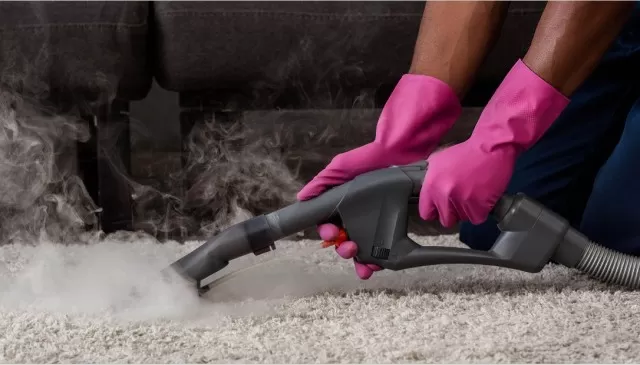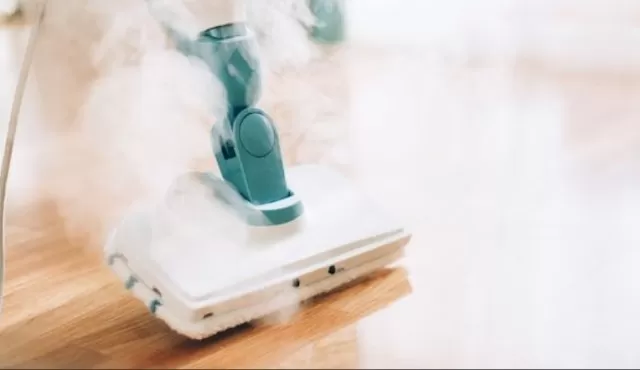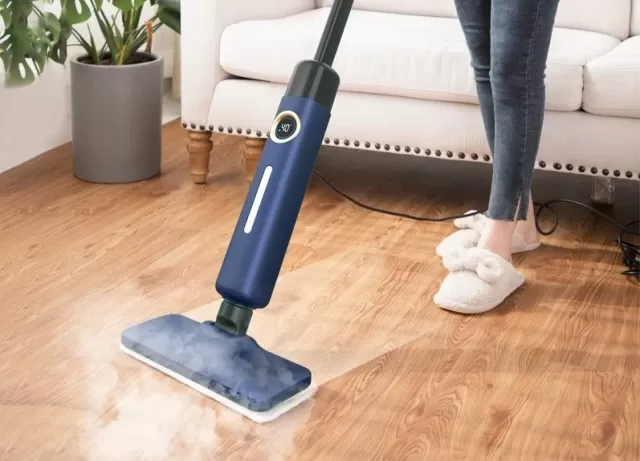Steam cleaners are versatile machines that use high-temperature steam to clean and sanitize various hard surfaces.
They typically come in a canister-style design with a nozzle that can be equipped with different attachments for specific cleaning tasks.
Pros and Cons

Here’s how to use a hard-surface steam cleaner and some pros and cons to consider:
Using a Hard-Surface Steam Cleaner:
Read the instructions: Familiarize yourself with the manufacturer’s instructions for your specific steam cleaner model.
Fill the water tank: Fill the water tank of the steam cleaner with distilled or filtered water, following the recommended fill level.
Attach the desired accessory: Choose the appropriate attachment for the surface you are cleaning, such as a brush for scrubbing or a squeegee for windows.
Attach it securely to the nozzle.
Preheat the steam cleaner: Plug in the steam cleaner and allow it to heat up according to the manufacturer’s instructions, typically for a few minutes.
Start cleaning: Hold the steam cleaner nozzle close to the surface you want to clean and press the steam button or trigger to release steam.
Move the nozzle slowly and evenly across the surface, allowing the steam to penetrate and loosen dirt or grime.
Wipe or scrub as needed: Depending on the surface and the attachment used, you may need to wipe or scrub the loosened dirt or grime with a cloth or brush.
Repeat if necessary: For stubborn stains or heavily soiled areas, you may need to repeat the process or use additional steam and agitation.
Properly dispose of excess water: Empty any remaining water from the tank and allow the steam cleaner to cool down before storing.
Pros of Using a Hard-Surface Steam Cleaner:
Effective cleaning and sanitizing: Steam cleaners can eliminate bacteria, germs, and allergens without the use of harsh chemicals.
Versatility: They can be used on a wide range of surfaces, including floors, countertops, tiles, appliances, upholstery, and more. Eco-friendly: Steam Cleaning reduces the need for chemical cleaners, making it a more environmentally friendly cleaning method.
Cons of Using a Hard-Surface Steam Cleaner:
Limited effectiveness on certain surfaces: Steam cleaners may not be suitable for delicate materials or surfaces that can be damaged by high heat or moisture.
Initial cost: Steam cleaners can be more expensive than traditional Cleaning Tools. Preparation and drying time: Preheating the machine and waiting for surfaces to dry after cleaning can take some time.
Consider these pros and cons to determine if a hard-surface steam cleaner is a worthwhile addition to your cleaning routine.
Various types of steam-cleaners

The term “steam cleaner” can encompass various types of steam-cleaning tools.
Here’s an overview of the different types:
Fabric and Clothing Steamers: These steamers are designed to remove wrinkles and freshen fabrics.
They come in handheld or upright models and use steam to relax the fibers of the fabric, making it easier to remove wrinkles without the need for an iron.
Hard-Surface or Multi-Surface Steam Cleaners: These steam cleaners are specifically designed to deep clean and sanitize sealed hard surfaces such as tile, grout, countertops, and plumbing fixtures.
They often come with various attachments to tackle different surfaces and can provide effective cleaning without the need for harsh chemicals.
Steam Mops: Steam mops are mops that use steam, in addition to water and sometimes cleaning agents, to clean hard floors.
They typically have a built-in water tank and heating element to produce steam, which is then released through a cleaning pad or mop head. Steam mops can be used on a variety of sealed hard floor surfaces like tile, laminate, and hardwood.
It’s important to note that some carpet and upholstery cleaners are also referred to as steam cleaners, although they may not use steam as the primary cleaning method.
These machines often utilize hot water extraction or a combination of water, detergent, and suction to clean carpets and upholstery.
When choosing a steam cleaner, it’s essential to consider the specific cleaning needs you have and select the type that best suits those requirements.
Way to Use a Steam Cleaner

These instructions outline the general steps for using a steam cleaner.
It’s important to note that specific steam cleaners may have variations in operation, so always refer to the manufacturer’s instructions for your particular model. Here’s a breakdown of the steps:
Prep the Surface:
Clean the surface before using the steam cleaner to remove dust, dirt, and debris.
Sweep, mop, or vacuum floors, and wipe down walls or flat surfaces with a microfiber cloth and a gentle all-purpose cleaner.
Choose the Right Attachment:
Select the appropriate attachment for the task you want to perform.
Common attachments include brushes for scrubbing, squeegees for glass and tile surfaces, scrapers for removing debris, and soft cloth attachments for delicate surfaces.
Set Up the Steam Cleaner:
Fill the steam cleaner’s tank with tap or distilled water.
Using distilled water may yield better results, especially in areas with hard water. Attach the chosen accessory to the machine.
Turn on the steam cleaner and allow it to heat up according to the manufacturer’s instructions.
Steam and Scrub:
Work in sections, applying steam to the area and using the attachment to scrub, scrape, wick, or polish the surface.
When cleaning vertical surfaces, start from the top and work your way down.
Rinse Surface:
Before moving on to a new section, rinse the cleaned area to remove any dirty runoff.
This helps prevent residue from settling back onto the surface.
Refill, Repeat, and Rinse:
Refill the steam cleaner with water as needed and continue working in sections, steaming, scrubbing, and rinsing until the entire task is completed.
After finishing, go over the entire area with a clean, damp cloth to remove any remaining cleaning residue. Always prioritize safety when working with steam cleaners, as the steam can be hot and cause burns.
Follow the manufacturer’s instructions and guidelines for safe operation.
What to Use and What to Avoid when a Steam Cleaner On

Using a steam cleaner on the appropriate surfaces can yield effective cleaning results.
However, it’s crucial to understand what surfaces are safe to clean with steam and what should be avoided. Here are some general guidelines:.
Surfaces that can typically be cleaned with steam:
- Sealed countertops
- Tile and grout
- Vinyl flooring
- Faucets
- Toilets
- kitchen appliances (e.g., refrigerator, oven, range, dishwasher)
- Sliding Door and window tracks
- Glass (avoid cold glass)
Surfaces to avoid cleaning with steam:
- Unsealed, polished, or waxed wood flooring, cabinets, or furniture
- Laminate flooring
- Painted surfaces, including walls
- Furniture and fabrications made of paper, wood, plywood, or composite cardboard
- Fine woodwork, including musical instruments and antiques
- Delicate fabrics
- Nylon mesh screens
- Cold glass
It’s important to consult the manufacturer’s instructions for your specific steam cleaner model to determine the recommended surfaces for steam cleaning.
If you’re unsure about the compatibility of steam with a particular surface, it’s always wise to test it in an inconspicuous area first and check for any damage after waiting for a while.
Additionally, remember to exercise caution when using steam cleaners, as the hot steam and attachments can cause severe burns.
Follow the manufacturer’s safety guidelines, wear protective gloves if necessary, and keep a safe distance from the steam to prevent injuries.
*The information is for reference only.